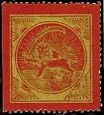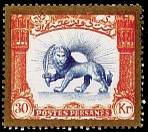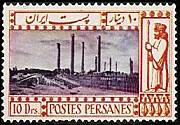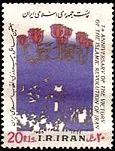Collecting Iranian stamps can be difficult, perplexing, and frustrating.
Few reference books are available in English. The many warnings published in the Scott Standard Postage Stamp Catalogue concerning counterfeits, reprints, and bogus issues are off-putting.
Yet Iranian philately is both intriguing and wonderful, though definitely not for those collectors seeking easy answers.
Because of Iran's strategic location, there is an abundance of interesting postal history.
One of the earliest recorded markings associated with Iran is on an 1858 folded letter sent to Bombay, India, stamped "FIELD FORCE 26 FE BG PERSIA." In 1864, the Indian government opened a post office in Bushire to shuttle mail to Teheran.
France was approached in 1865 to consider preparing Iranian postage stamps. A private businessman named A. Riester prepared evocative essays depicting a lion holding a sword and standing before a rising sun.
Similar essays were selected in Paris by the Persian delegation. Designed by A. Barre, these bear similarities to the Riester creations.
The imperforate Lion With Sword stamps, Scott 1-4, appeared in 1868. These stamps, which are known as the Bagheri issue, are shown above.
Printed in blocks of four, these stamps often are found cut into singles with very narrow margins. Numerous shades exist. Paper varies from thick to thin and can be either smooth or ribbed.
All four Lion With Sword stamps are known printed on both sides. Double impressions are known of some values. Watermarked examples are worth roughly four times more than unwatermarked examples.
The first issue was canceled only with pen marks; postmarked copies are not known. Many covers bear uncanceled stamps.
The 1875 issue (Scott 11-14) is rouletted vertically. In an attempt to conform to Western standards, numerals indicating face value were inserted under the lion. The 1876 printings are imperforate (Scott 15-20).
The 1875-76 issues were printed in strips of four, with each stamp separated by a wide gutter.
Some of the 1875 stamps were inadvertently released imperforate and can be distinguished from the 1876 issues by paper thickness.
The yellow 1876 1-kran Lion With Sword stamp is listed as a color error in the Scott catalog. Overseas, however, it is considered an essay. Only 500 were released.
Mint and canceled-to-order unofficial reprints exist for the 1875-76 issues. Identifying characteristics are given in the Scott catalog.
A four-stamp set released in 1876 pictures the monarch, Shah Nasr-ed-Din. Forgeries and reprints are known.
A 5-shahi stamped envelope was issued in 1876. Sales were unsuccessful, so the authorities announced that the stamp could be cut off the envelope and uesd on ordinary mail. Intact envelopes, either mint or used, are pricey today as few were retained intact.
In the 1870s, both the Lion and Shah issues were released with slight differences. Many more are listed as distinct varieties in overseas catalogs.
The lithographed Sun issues of 1881 are most familiar, as reprints abound. They were printed in Vienna. Small-size definitives (regular-issue) were issued in 1881-94.
The years 1898-1923 are dominated by many overprints and surcharges, largely on common stamps, making the stamps much more valuable. Many more types exist than are listed by Scott.
These are probably the most challenging issues for the novice collector. In many cases, Scott notes basic rules to identify genuine stamps. The wise collector should consider every unauthenticated item as not genuine.
Fortunately, the Iran Study Circle offers its expertizing services to members.
The IPSC web site offers much information, including an excellent discourse titled "Is it genuine?"
The philatelic terms forgery, reprint, imitation, bogus, and canceled-to-order are carefully explained. Heightened security and certification also are discussed.
For a membership application, send a No. 10 addressed, stamped envelope to Darrell Hill, 1410 Broadway, Bethlehem, PA 18015.
Even the basic stamps issued from 1868 to 1923 have been reprinted. For more collector appeal, stamps with inverted centers were reprinted as well.
Even the postal authorities participated in these scams. The postmasters would make original cliches (an individual printing unit, usually consisting of the design of a single stamp, combined with others to make a complete printing plate) available in order for reprints to be made. These reprints were then sold to foreign dealers.
Genuine examples of most surcharges and overprints in this era exist inverted, doubled, and misshapen.
The 1902 Chahis and Krans overprint issue, for example, is found with tete-beche overprints. A stamp with an inverted overprint is se-tenant to a stamp with an upright overprint.
Adding to the enjoyment of collecting Iranian stamps are numerous anti-government issues, as well as unissued stamps. A 1915 set of 19 values depicting monarchs and the 1909 Lion service set with fancy artwork (the 30k value is shown above) were not officially issued.
Riza Shah Pahlavi, father of the Shah deposed in 1979 by the Ayatollah Khomeini, is the subject of several well-designed sets, starting in 1926.
The 1831-34 sets (Scott 760-85) offer numerous perforation errors. Other varieties include vignette shifts, double impressions, and misapplied colors.
Figure 4 shows a 10-dinar stamp (Scott 787) issued in 1935 to commemorate the 10th anniversary of Shah Pahlavi's reign. The stamp is part of a nine-stamp set and depicts the ruins of Persepolis.
Counterfeits and reprints are not a problem with these stamps. Many collectors, wishing to avoid the problematical earlier years, start with the Pahlavi issues.
Scott only recently listed the 1939 issue honoring Riza Shah Pahlavi's 60th birthday. These eight stamps were printed in the Netherlands in small panes (perforated and imperforate) of four stamps. The 1-rial and 2r values were only sold overseas.
As th eeconomy improved, and especially with Mohammed Riza Pahlavi replacing his father as monarch, better designed stamps became the rule.
Errors of perforation, double impressions, and inverted centers are found on just a few later issues.
Several values of the long 1940s and 1950s regular issues are modern rarities, as few were retained by collectors.
These later issues honor Iranian culture. Many sets also recognize the shah and his family.
Birthdays, marriages, and reign anniversaries were frequently honored.
The shah's portrait is overprinted with seven vertical lines on Scott 2008-18, issued in 1979 to herald the Islamic Revolution that deposed the shah that same year.
The 15r value (Scott 2012) from this set is shown above. The black overprint on the central image means "Islamic Revolution."
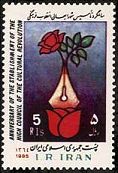
Many subsequent issues honor the revolution. Above left is a 1985 stamp honoring the High Council of the Cultural Revolution and picturing roses.
Another revolutionary stamp depicting roses is illustrated above right. An inscription on the right of this 20r stamp reads "7th Anniversary of the Victory of the Islamic Revolution in Iran."
Many anti-United States and anti-Israel stamps are an unfortunate reminder of the new regime's politics. Fortunately, these stamp subjects are in the minority.
With numerous local, revolutionary, revenue, and other limited-usage Iranian stamps not listed in the Scott catalogue, there's a wealth of material to collect.
Various specialized catalogs provide helpful illustrations and English-language explanations. Many dealers are unfamiliar with these interesting items.
For example, Figure 8 displays an imperforate example from the Sattar-Khan issue. Tabriz, a revolutionary group led by Sattar Khan, issued this stamp and three others in 1909. The stamps were not postally used.
There are some noteworthy literature and supply sources for collectors of Iran.
A web site specializing in the stamps and postal history of Iran (PersiPhila) and the aforementioned IPSC web site offer specialized albums.
Specialist auction catalogs are helpful. David Feldman's 1987 Persia - the Grand Prix Collection auction catalog is the source of some photographs and descriptions used in this article.
Overall, though, there's not much in print for the collector. For this article I've used N. Farabakhsh's Stamps of Iran color catalog (published in 1999). It's available for $30 plus postage from the PersiPhila web site.
Another useful source is an article that appeared in the February 1983 issue of The American Philatelist. In his "Pitfalls of Iranian Philately," A. John Ultee helps collectors identify some of the many early forgeries and reprints.
The American Philatelist is the monthly journal of the American Philatelic Society.
APS members can access additional materials through its research library. Readers interested in APS membership should write to the APS, Box 8000, State College, PA 16803.
